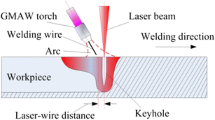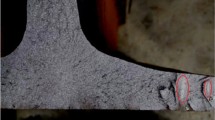Abstract
An appropriate temperature field before the upsetting process plays a key role in the quality of joints, and the temperature of rail flash butt welding (FBW) is mainly formed by the Joule heat generated by the current passing through the end face contact resistance; therefore, it is necessary to study the current distribution and end face heating during rail welding. In this study, through a combination of finite element simulation and experiment, an electric–thermal bidirectional coupling model of alternating current rail FBW is established, and the distribution of alternating current (AC) inside the rail and influence of the electrode feeding mode on the heating uniformity of the end face are investigated. The results demonstrate that the skin effect at the bottom of the rail is the most significant when the AC passes through the low-temperature variation area of the rail. The AC flowed along the surface of the rail, and the current near the end face flowed from the surface to the inside of the rail. The current distribution on the end face is almost uniform. In addition, the temperature distribution of the hybrid-type feeding method is the most uniform on the end face under AC power, and the fixed type has poor uniformity. The maximum difference between the simulated value and the measured value of the temperature interval width is 2.9 mm, and the error is controlled within 8.3%. The calculated results are in line with the measured results, indicating that the model established in this study is reasonable and feasible.














Similar content being viewed by others
Availability of data and material
Data and materials will be available upon request.
References
Godefroid LB, Faria GL, Cândido LC, Viana TG (2014) Fatigue failure of a flash butt welded rail. Procedia Mater Sci 3:1896–1901. https://doi.org/10.1016/j.mspro.2014.06.306
Stone DH, Iwand HC, Kristan J, Lehnhoff GR (2015) Flash butt rail weld vertical fractures. J Fail Anal Prev 15:33–38. https://doi.org/10.1007/s11668-014-9916-1
Zhao X, Fan Y, Liu Y, Wang HY, Dong P (2015) Evaluation of fatigue fracture mechanism in a flash butt welding joint of a U75V type steel for railroad applications. Eng Fail Anal 55:26–38. https://doi.org/10.1016/j.engfailanal.2015.05.001
Zhang Q, Li L, Ding W, Song HT, Gao ZK (2016) Investigation on process and welded joint mechanical properties of bainitic steel rail flash butt welding. Key Eng Mater 723:406–411. https://doi.org/10.4028/www.scientific.net/KEM.723.406
Reng DL, Li XG (2003) Seamless rail welding technolog. Weld Tech 5:4–5. https://doi.org/10.13846/j.cnki.cn12-1070/tg.2003.05.002
Guo MH, Zhao MH, Deng BW, Dong BW (2003) Progression of non-gap joining technique of railway rail. Welding 3:5–9
Ichiyama Y, Ichikawa M, Saito T (2004) The effect of upsetting conditions on flash weld toughness. Study on toughness improvement of flash welded joints in high strength steel. Weld Int 18:683–691. https://doi.org/10.1533/wint.2004.3317
Zhang AH, Gao FL, Niu XG, Luo H (2016) Prediction of gray-spot area in rail flash butt welded joint based on BP neural network. Trans China Weld Inst 11:11–14
Ozakgul K, Piroglu F, Caglayan O (2015) An experimental investigation on flash butt welded rails. Eng Fail Anal 57:21–30. https://doi.org/10.1016/j.engfailanal.2015.07.009
Xu Z, Lu P, Shu Y (2016) Microstructure and fracture mechanism of a flash butt welded 380CL steel. Eng Fail Anal 62:199–207. https://doi.org/10.1016/j.engfailanal.2016.02.005
Zhang J, Zhang X, Li D et al (2019) Extrusion behavior of impurities in upsetting process of rail flash butt welding based on finite element method. J Mater Res 34:3351–3360. https://doi.org/10.1557/jmr.2019.221
Ding HP, Bao XQ, Janili-Shirvan Z, Jin JS, Deng L, Yao KF, Gong P, Wang XY (2021) Enhancing strength-ductility synergy in an ex situ Zr-based metallic glass composite via nanocrystal formation within high-entropy alloy particles. Mater Design 210:110108. https://doi.org/10.1016/j.matdes.2021.110108
Li XF, Yi DH, Wu XY, Zhang JF, Yang XH, Zhao ZX, Feng YH, Wang JH, Bai PK, Liu B, Liu Y (2021) Effect of construction angles on microstructure and mechanical properties of AlSi10Mg alloy fabricated by selective laser melting. J Alloys Compd 881:160459. https://doi.org/10.1016/j.jallcom.2021.160459
Zhong Y, Xie JL, Chen YH, Yin LM, He P, Lu WW (2021) Microstructure and mechanical properties of micro laser welding Nitinb/Ti6al4v dissimilar alloys lap joints with nickel interlayer. Mater Lett 306:130896. https://doi.org/10.1016/j.matlet.2021.130896
Tawfik D, Kirstein O, Mutton PJ, Chiu WK (2006) Verification of residual stresses in flash-butt-weld rails using neutron diffraction. Phys B 385–386:894–896. https://doi.org/10.1016/j.physb.2006.05.242
Ma R, Huang D, Zhang J et al (2020) Effects of rail flash-butt welding and post-weld heat treatment processes meeting different national standards on residual stresses of welded joints. Int J Mater Res 111:780–787. https://doi.org/10.3139/146.111935
Xie YM, Meng XC, Mao DX, Qin ZW, Wan L, Huang YX (2021) Homogeneously dispersed graphene nanoplatelets as long-term corrosion inhibitors for aluminum matrix composites. ACS Appl Mater Inter 27:32161–32174. https://doi.org/10.1021/acsami.1c07148
Zheng H, Li Y (2009) On computer simulation models of RSW process. In: 2009 International Conference on Computer Engineering and Technology. IEEE, Singapore, Singapore, pp 176–179
Theddeus MP (2002) Finite element analysis of resistance spot welding in aluminum. Sci Technol Weld Join 7:111–118. https://doi.org/10.1179/136217102225001331
Feulvarch E, Robin V, Bergheau JM (2004) Resistance spot welding simulation: a general finite element formulation of electrothermal contact conditions. J Mater Process Technol 153–154:436–441. https://doi.org/10.1016/j.jmatprotec.2004.04.096
Wu FS, Zhang GF, Wang SY, Shi YW (1998) Finite element analysis of DC resistance butt welding process. Chin J Mech Eng 6:90–96. https://doi.org/10.3321/j.issn:0577-6686.1998.06.016
Xu XF, Liu L, Guan ZK (2008) Finite element analysis on the temperature field distribution of flash butt welding of rail. J Shanghai Jiaotong U 5:778–781. https://doi.org/10.16183/j.cnki.jsjtu.2008.05.021
Sittisrijan N, Ruangsinchaiwanich S (2011) Analysis of stator current waveforms of induction motor with broken bar conditions. In: 2011 International Conference on Electrical Machines and Systems. IEEE, Beijing, China, pp 1–6
Li WL, Xie Y, Shen JF, Luo YL (2007) Finite element analysis of field distribution and characteristic performance of squirrel cage induction motor with broken bars. IEEE T Magn 43:1537–1540. https://doi.org/10.1109/TMAG.2006.892086
Liang X, Ali MZ, Zhang H (2020) Induction motors fault diagnosis using finite element method: a review. IEEE Trans Ind Appl 56:1205–1217. https://doi.org/10.1109/TIA.2019.2958908
Ma N, Cai Z, Huang H et al (2015) Investigation of welding residual stress in flash-butt joint of U71Mn rail steel by numerical simulation and experiment. Mater Des 88:1296–1309. https://doi.org/10.1016/j.matdes.2015.08.124
Radu B, Codrean C, Cojocaru R, Ciucă C (2016) Numerical modeling of thermal field distribution during friction stir welding (FSW) of dissimilar materials. Solid State Phenom 254:261–266. https://doi.org/10.4028/www.scientific.net/SSP.254.261
Weingrill L, Krutzler J, Enzinger N (2016) Temperature field evolution during flash butt welding of railway rails. Mater Sci Forum 879:2088–2093. https://doi.org/10.4028/www.scientific.net/MSF.879.2088
Feng B, Ribeiro A, Rocha T, Ramos H (2018) Comparison of inspecting non-ferromagnetic and ferromagnetic metals using velocity induced eddy current probe. Sensors 18:3199. https://doi.org/10.3390/s18103199
Zhao XH, Feng JC (2007) Pressure welding method and equipment. China Machine Press, Beijing
Qu HR (2009) Numerical simulation of temperature and phase field during rail-end quenching process. Dissertation, Wuhan University of Science and Technology
Funding
This work was supported by the National Key R&D Program of China under Grant 2016YFB1102603.
Author information
Authors and Affiliations
Corresponding author
Ethics declarations
Ethics approval
Not applicable.
Consent to participate
Not applicable.
Consent for publication
Not applicable.
Conflict of interest
The authors declare no competing interests.
Additional information
Publisher's Note
Springer Nature remains neutral with regard to jurisdictional claims in published maps and institutional affiliations.
Rights and permissions
About this article
Cite this article
Wang, X., Liu, X., Zhang, J. et al. Numerical simulation of end face heating in alternating current flash butt welding based on electrical–thermal bidirectional coupling. Int J Adv Manuf Technol 120, 173–183 (2022). https://doi.org/10.1007/s00170-021-08599-7
Received:
Accepted:
Published:
Issue Date:
DOI: https://doi.org/10.1007/s00170-021-08599-7




